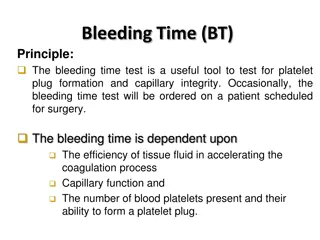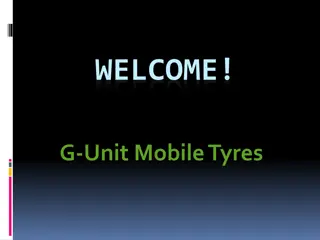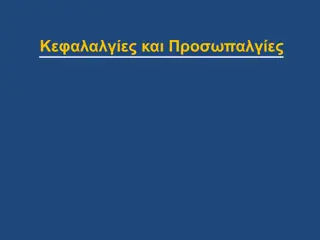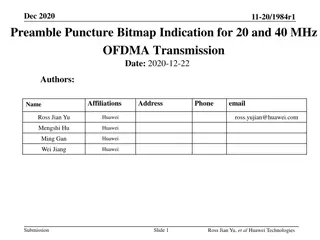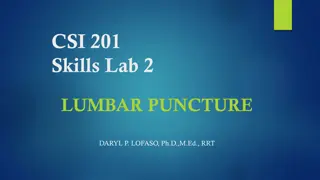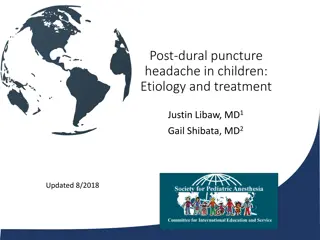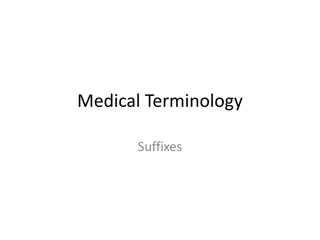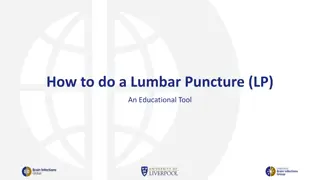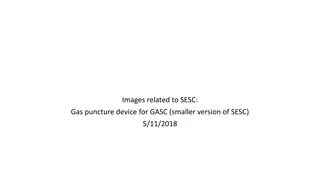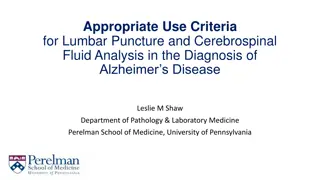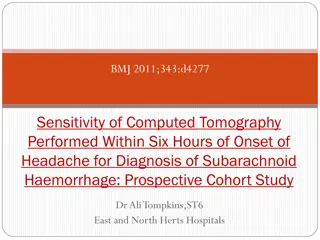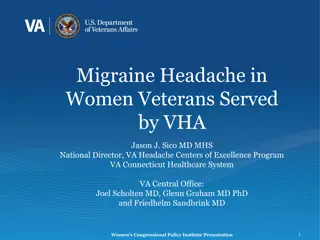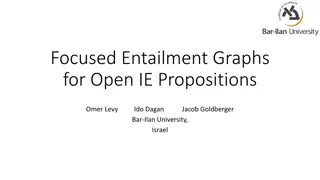Understanding Post-Dural Puncture Headache in Children
Discussing the etiology, diagnosis, risk factors, and management of post-dural puncture headache (PDPH) in children. Historical background, neuraxial anatomy, and incidence rates in both adults and children are explored, emphasizing different needle types and gauges influencing PDPH occurrence.
Download Presentation

Please find below an Image/Link to download the presentation.
The content on the website is provided AS IS for your information and personal use only. It may not be sold, licensed, or shared on other websites without obtaining consent from the author. Download presentation by click this link. If you encounter any issues during the download, it is possible that the publisher has removed the file from their server.
E N D
Presentation Transcript
Post-dural puncture headache in children: Etiology and treatment Justin Libaw, MD1 Gail Shibata, MD2 Updated 8/2018
Objectives Review the epidemiology, etiology and diagnosis of post-dural puncture headache (PDPH) Present risk factors for PDPH Review the management and treatment of PDPH Discuss epidural blood patch as treatment of PDPH in children Consider the differences in etiology and treatment of PDPH in adults as compared to children
What is PDPH? A headache occurring within 5 days of lumbar puncture The headache is classically positional and worse when upright, resolving when lying flat10
A bit of history Corning injects cocaine between the spinous processes of the lower lumbar vertebrae in a healthy man, likely the first neuraxial anesthetic 1885 Quincke uses a needle with a sharp, bevelled tip to aspirate CSF from the subarachnoid space for the treatment of intracranial hypertension 1891 Bier conducts the first spinal anesthetic using cocaine. When his subjects experience the symptoms of PDPH, he becomes the first to describe it.29 1898 Needles with smooth, rounded tips are developed and improved upon in later years by Whitacre and Hart (1951), Sprotte (1987), and others. 1920s
Neuraxial anatomy The spinal cord has three membranes: Dura mater Arachnoid mater Pia mater These membranes create three spaces: Epidural space Subdural space Subarachnoid space The dura contains the cord and nerve roots. Perforating it can result in CSF leakage out of the subarachnoid space and post-dural puncture headache29 Image from Memorang , D.Stark, Y. Cohen
How common is PDPH? In the late 19th century, incidence was as high as 66%, but decreased dramatically with the development of more advanced spinal needles29 Incidence in adults varies between 1.5% and 33%, depending on risk factors, particularly needle size10 Incidence in children varies between 1% and 4% when small gauge needles are used, and rises to as high as 15% with a 22 gauge needle2,16,29
How common is PDPH? Needle type Needle gauge Incidence of PDPH (%) Quincke (cutting) 24 11.2 Quincke 25 6.4 Quincke 26 5.6 Quincke 27 2.9 Needle type Needle gauge Incidence of PDPH (%) Whitacre (pencil-point) 22 1.5 Sprotte (pencil-point) 24 3.5 Whitacre 25 2.0 Whitacre 27 1.6
Etiology Two theoretical mechanisms producing PDPH: 1) CSF loss and lowering of CSF pressure causes traction on pain-sensitive structures leading to headache 2) Compensatory vasodilation of intracranial vessels to increase CSF production leading to headache29 Intracranial contents Brain tissue CSF Blood 10% 10% 80%
Diagnosis Hallmark symptom is postural headache Present when upright, resolves when lying flat Severe, dull, commonly bi-frontal or occipital Associated symptoms: neck & shoulder pain, neck stiffness, nausea, visual changes, dizziness4,10,28 It is important to consider other causes of headache after a dural puncture. Diagnosis can be more difficult in the younger, nonverbal patient
Diagnosis 24 to 72 hours later PDPH most often resolves in 3 to 7 days with conservative measures28 Lumbar puncture Procedure performed Onset of PDPH is typically 24 to 48 hours after dural puncture, with 90% beginning by 72 hours4,29 3 to 7 days later
Risk factors Modifiable risk factors for PDPH3,10 Equipment-related Needle diameter Higher incidence of PDPH with larger gauge needle Needle shape and type Quincke = traumatic, cutting, opening at tip Whitacre, Sprotte = atraumatic, pencil-point, opening before tip Higher incidence of PDPH with cutting needles Image from Turnbull JH, Aleshi P. Spinal and Epidural Anesthesia. In: Sikka P, Beaman S, Street J (eds) Basica Clinical Anesthesia. Springer, New York, NY.
Risk factors Modifiable risk factors for PDPH3,10 Procedure-related Needle orientation Lower incidence of PDPH when bevel of traumatic needle is inserted parallel to the long axis of the spine Stylet reinsertion Lower incidence of PDPH when stylet reinserted before removal Operator experience Lower incidence of PDPH with experienced operators Image from Mihic DN. Post spinal headache and relationship of needle bevel to longitudinal dural fibers. Regional Anesthesia and Pain Medicine. 1985;10(2): 76-81.
Risk factors Nonmodifiable risk factors for PDPH4 Age Highest risk 20-30, decreases over 40 Similar in adolescents as compared to adults May be lower in young children, but controversial Females > males Low body mass index (BMI) History of prior PDPH History of chronic headache before lumbar puncture No correlation to migraine history
Treatment Most PDPHs are self-limited, most resolving in 7 days with no treatment10,29 Conservative management is the first-line therapy in both adults and children10 If PDPH persists, the decision to escalate care depends on severity of symptoms and patient preferences3
Treatment: Conservative Bedrest: Postpones, but does not prevent or cure Hydration: No evidence to support increase in CSF; transient relief only Symptomatic treatment: Medical management Caffeine10 Single dose of oral caffeine (300 mg) or IV caffeine sodium benzoate Relief within 4 hours after given 70% of patients, symptoms did not recur Lacking evidence for effectiveness; temporary relief
Treatment: Medical management Evidence for effectiveness of conservative medical management is lacking10 Medication Evidence Acetaminophen/paracetamol Can be effective for short-term, symptomatic relief Caffeine, theophylline Can be effective for short-term, symptomatic relief10,28 Others (sumatriptan3,10,29; desmopressin, vasopressin28,29; ethanol, nicotinic acid, inhaled carbon dioxide28; ACTH, mirtazipine, gabapentin, pregabalin, methergine, metoclopramide, intravenous hydrocortisone, epidural morphine3) Poor evidence and not commonly used in practice
Epidural blood patch 75 to 96% success rate10 Gold standard for PDPH, if conservative management fails Injection of saline does not provide the same relief
Epidural blood patch Pressure Patch Mechanism Plug Patch Mechanism Injected blood increases epidural pressure Injected blood forms a plug Compresses the dura and displaces CSF upward into the cranium Sealing the dural hole Restores intra- cranial volume/ pressure Preventing further CSF leak Reduces traction on pain fibers
Epidural blood patch Adverse effects Back pain - 35% Neck pain - 1% Transient temperature spike 24-48 hours - 5% Infection, bleeding - Rare Contraindications - Related to needle placement Coagulopathy Sepsis Local infection Anatomic abnormality Fever
Epidural blood patch Injection of a patient s own blood into the epidural space with sterile technique Administered as close to the site of original dural puncture, at the same or a lower interspace. Approximately 20 to 30 mL of blood in adults3,10 Stop injection if patient has neck or back pain or pain radiating down legs Patient lies flat for at least 1 hour after procedure Image from Wikimedia
Epidural blood patch Highly effective and safe in pediatric patients16 Conservative treatment is still first line and usually adequate Epidural blood patch in children is technically similar to the procedure in adults 0.2 0.3 mL/kg is an appropriate amount of autologous blood for injection10,30 Mechanisms of success are the same as in adults Success is high at approximately 70%, and perhaps greater16,30
You are asked to perform epidural blood patch for a child with PDPH History 10 year old boy, 31 kg Inguinal hernia repair 2 days ago Anesthesia: Spinal anesthesia with 25 gauge cutting needle Complaint of headache and nausea Physical Exam Vitals are all normal. Alert and oriented. He describe his headache pain as 5/10 with sitting or standing upright and 1/10 lying flat. Diagnosed with PDPH How should Thomas be treated?
You are asked to perform an epidural blood patch for a child with PDPH Conservative treatment! Conservative medical therapies should be attempted first at this early stage and given the mild severity of symptoms Bedrest Hydration Caffeine Symptom management with pain medicines (e.g., acetaminophen, NSAIDs) and antiemetics Thomas is sent home. His headache is still present a week later and has worsened to 8/10. He has missed several days of school. How should Thomas be treated now?
You are asked to perform an epidural blood patch for a child with PDPH Epidural blood patch! Consider the following: Standard monitors Oxygen saturation, ECG, blood pressure Intravenous access Sedation or general anesthesia, as necessary Lateral decubitus or sitting position Aseptic preparation of the back and a peripheral vein One provider perform epidural under sterile technique A separate provider draw 0.2 to 0.3 mL/kg of blood from a peripheral vein under sterile technique Inject the blood in the epidural space under sterile technique Thomas s headache resolves in seconds. He returns home and is back to school the next day.
PDPH in adults versus children: What s the difference? Similarities: Definition Etiology Risk factors Treatment Differences: Incidence Children may be less likely to experience PDPH or more likely to respond to conservative management Symptoms Children may be unable to communicate common symptoms
Conclusions Post-dural puncture headache is a relatively common complication after lumbar puncture and spinal or epidural anesthesia in children The classic symptom is postural headache with onset 24 to 48 hours after dural puncture Etiology of PDPH is uncertain, but several theories have been proposed Important risk factors include needle diameter and type Conservative management is first-line therapy, but epidural blood patch is a highly effective treatment option in children if headache persists or is severe
References 1. Amorim JA, Barros MVGD, Valen a MM. Post-dural (post-lumbar) puncture headache: Risk factors and clinical features. Cephalalgia. 2012;32(12):916-923. doi:10.1177/0333102412453951. 2. Apiliogullari S, Duman A, Gok F, Akillioglu I. Spinal needle design and size affect the incidence of postdural puncture headache in children. Pediatric Anesthesia. 2010;20(2):177-182. doi:10.1111/j.1460-9592.2009.03236.x. 3. Bezov D, Ashina S, Lipton R. Post-Dural Puncture Headache: Part II - Prevention, Management, and Prognosis. Headache: The Journal of Head and Face Pain. 2010;50(9):1482-1498. doi:10.1111/j.1526-4610.2010.01758.x. 4. Bezov D, Lipton R, Ashina S. Post-Dural Puncture Headache: Part I - Diagnosis, Epidemiology, Etiology, and Pathophysiology. Headache: The Journal of Head and Face Pain. 2010;50(7):1144-1152. doi: 10.1111/j.1526-4610.2010.01699.x. 5. Borges BCR, Wong G, Isaac L, Hayes J. Unusual presentation of postdural puncture headache requiring repeat epidural blood patch in a 4-year-old child. Pediatric Anesthesia. 2013;24(5):541-543. doi:10.1111/pan.12330. 6. Cassady JF, Lederhaas G, Turk WR, Shanks DE. Unusual Presentation and Treatment of Postlumbar Puncture Headache in an 11-yr-old Boy. Anesthesiology. 2000;92(6):1835. doi:10.1097/00000542-200006000-00047. 7. Crock C, Orsini F, Lee KJ, Phillips RJ. Headache after lumbar puncture: randomised crossover trial of 22-gauge versus 25-gauge needles. Archives of Disease in Childhood. 2013;99(3):203-207. doi:10.1136/archdischild-2013-305145. 8. Ebinger F, Kosel C, Pietz J, Rating D. Headache and Backache After Lumbar Puncture in Children and Adolescents: A Prospective Study. Pediatrics. 2004;113(6):1588-1592. doi:10.1542/peds.113.6.1588. 9. Hunyady AI, Anderson CTM, Kuratani JD, Kundu A. Fever following an Epidural Blood Patch in a Child. Case Reports in Anesthesiology. 2012;2012:1-4. doi:10.1155/2012/753875. 10. Janssens E, Aerssens P, Alliet P, Gillis P, Raes M. Post-dural puncture headaches in children. A literature review. European Journal of Pediatrics. 2003;162(7-8):567-567. doi:10.1007/s00431-003-1271-2.
References 11. Kara I, Ciftci I, Apiliogullari S, Arun O, Duman A, Celik JB. Management of postdural puncture headache with epidural saline patch in a 10-year-old child after inguinal hernia repair: A case report. Journal of Pediatric Surgery. 2012;47(10). doi:10.1016/j.jpedsurg.2012.07.055. 12. Kokki H. Spinal blocks. Pediatric Anesthesia. 2011;22(1):56-64. doi:10.1111/j.1460-9592.2011.03693.x. 13. Kokki H, Heikkinen M, Turunen M, Vanamo K, Hendolin H. Needle design does not affect the success rate of spinal anaesthesia or the incidence of postpuncture complications in children. Acta Anaesthesiologica Scandinavica. 2000;44(2):210-213. doi:10.1034/j.1399- 6576.2000.440213.x. 14. Kokki H, Hendolin H, Turunen M. Postdural puncture headache and transient neurologic symptoms in children after spinal anaesthesia using cutting and pencil point paediatric spinal needles. Acta Anaesthesiologica Scandinavica. 1998;42(9):1076-1082. doi:10.1111/j.1399-6576.1998.tb05379.x. 15. Kokki H, Salonvaara M, Herrgard E, Onen P. Postdural puncture headache is not an age-related symptom in children: a prospective, open-randomized, parallel group study comparing a22-gauge Quincke with a 22-gauge Whitacre needle. Pediatric Anesthesia. 1999;9(5):429-434. doi:10.1046/j.1460-9592.1999.00398.x. 16. Kokki M, Sj vall S, Kokki H. Epidural blood patches are effective for postdural puncture headache in pediatrics - a 10-year experience. Pediatric Anesthesia. 2012;22(12):1205-1210. doi:10.1111/pan.12034. 17. Lee DH, Kim E. Management of postdural puncture headache with epidural blood patch in a child. Korean Journal of Anesthesiology. 2011;61(4):344-345. doi: 10.4097/kjae.2011.61.4.344. 18. Lee LC-Y, Sennett M, Erickson JM. Prevention and Management of Post Lumbar Puncture Headache in Pediatric Oncology Patients. Journal of Pediatric Oncology Nursing. 2007;24(4):200-207. doi:10.1177/1043454207303884. 19. Liley A, Manoharan M, Upadhyay V. The management of a postdural puncture headache in a child. Pediatric Anesthesia. 2003;13(6):534-537. doi:10.1046/j.1460-9592.2003.01116.x. 20. Lowery S, Oliver A. Incidence of postdural puncture headache and backache following diagnostic/therapeutic lumbar puncture using a 22G cutting spinal needle, and after introduction of a 25G pencil point spinal needle. Pediatric Anesthesia. 2008;18(3):230-234. doi:10.1111/j.1460-9592.2008.02414.x.
References 21. Macarthur A. Chapter 31: Postpartum Headache. In: Chestnut D, et al. Chestnut s Obstetric Anesthesia: Principles and Practice. Philadelphia, PA: Elsevier/Saunders, 2014. 22. Mchale J, Odonovan FC. Postdural puncture symptoms in a child. Anaesthesia. 1997;52(7):688-690. doi:10.1111/j.1365- 2044.1997.az0158b.x. 23. Nafiu OO, Monterosso D, Walton SR, Bradin S. Post dural puncture headache in a pediatric patient with idiopathic intracranial hypertension. Pediatric Anesthesia. 2005;15(9):778-781. doi:10.1111/j.1460-9592.2004.01529.x. 24. Noble VS, Davagnanam I, Farmer S. Intractable headache after lumbar puncture. Bmj. 2011;343(aug08 1):d4529-d4529. doi:10.1136/bmj.d4529. 25. Oliver A. Dural punctures in children: what should we do? Pediatric Anesthesia. 2002;12(6):473-477. doi:10.1046/j.1460- 9592.2002.00806.x. 26. Paech MJ, Doherty DA, Christmas T, Wong CA, Epidural Blood Patch Trial Group. The Volume of Blood for Epidural Blood Patch in Obstetrics: A Randomized, Blinded Clinical Trial. Anesthesia & Analgesia. 2011;113(1):126-133. doi: 10.1213/ANE.0b013e318218204d. 27. Ramamoorthy C, Geiduschek JM, Bratton SL, Miser AW, Miser JS. Postdural Puncture Headache in Pediatric Oncology Patients. Clinical Pediatrics. 1998;37(4):247-251. doi:10.1177/000992289803700405. 28. Robins B, Boggs DP. Caudal Epidural Blood Patch for Treating Intractable Vomiting in a Child After Placement of a Permanent Intrathecal Catheter. Anesthesia and Analgesia. 2001:1169-1170. doi:10.1097/00000539-200105000-00017. 29. Tobias JD. Postdural Puncture Headache in Children. Clinical Pediatrics. 1994;33(2):110-113. doi:10.1177/000992289403300208. 30. Turnbull DK. Post-dural puncture headache: pathogenesis, prevention and treatment. British Journal of Anaesthesia. 2003;91(5):718-729. doi:10.1093/bja/aeg231. 31. Ylonen P, Kokki H. Epidural blood patch for management of postdural puncture headache in adolescents. Acta Anaesthesiologica Scandinavica. 2002;46(7):794-798. doi:10.1034/j.1399-6576.2002.460707.x. 32. Ylonen P, Kokki H. Management of postdural puncture headache with epidural blood patch in children. Pediatric Anesthesia. 2002;12(6):526-529. doi:10.1046/j.1460-9592.2002.00863.x.


